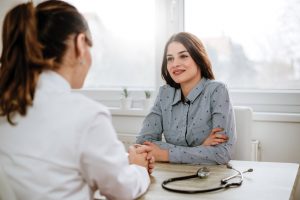Inspired to Take Action
Progress continues to be made in women’s health thanks to dedicated providers throughout Central Florida who are researching and implementing new treatment methods.

Although Lindsay Kissane, MD, long knew that she wanted to pursue a career in health care, it wasn’t until medical school that her goals really started to come into focus. That’s when a beloved family member suffered a pelvic organ prolapse, and she suddenly knew what path she was meant to follow.
“It really put a desire in me to help people because I was able to see firsthand how much these kinds of problems can affect quality of life,” says Dr. Kissane, a board-certified urogynecologist at AdventHealth who specializes in female pelvic medicine and reconstructive surgery.
“Once patients are better after surgery and a short recovery, which most of my surgeries have, they’re back to doing the things they love with minimal bother from any kind of pelvic floor disorder. It’s really gratifying—that’s why I love the field.”
Jennifer West, a certified physician’s assistant, was similarly inspired to pursue her profession. She is currently the director of medical operations and an investigator at K2 Medical Research, with an emphasis on clinical trials related to Alzheimer’s disease.
“I had a grandparent with Alzheimer’s disease, so it’s definitely something that’s close to my heart,” she says. “I’ve been in research about seven years now, and we’ve had two drugs that were approved by the FDA during that time, so that’s been really exciting, because before that I think it had been around 30 years since the last drug was approved. Even though it’s been slow-going, we’re starting to see some traction now.”
Each year at this time, Orlando Family Magazine takes the opportunity to shine a light on women’s health and some of the latest advancements being implemented in Central Florida to address a variety of issues. We spoke to several of the influential providers in the area to learn more about the world-class treatment that is available.
A welcome alternative
One of the common issues that Dr. Kissane can help with is stress urinary incontinence (SUI), which is the sudden, involuntary loss of urine as a result of pressure on the bladder from such activities as laughing, coughing or sneezing. Often considered a “geriatric problem,” Dr. Kissane explains that it can actually affect women from a wide range of ages. She sees patients from their 30s to their 90s, with risk factors including pregnancy, child birth, genetics and aging.
SUI can greatly impact a woman’s daily life, from working to simply playing with her kids, and will often lead to them avoiding public places. But the good news is that there are effective treatment options available.
“The gold standard for this problem is called the midurethral sling, which is great and has really high cure rates, around 85-95%, and lasts for a very long time,” Dr. Kissane says. “But it requires you to go to the operating room to have the procedure done, and it requires six weeks of downtime.”
The alternative of urethral blocking, she adds, in which bulking agents are injected into the urethra to prevent leaking, has been a strong alternative to surgery for some time. The problem was, there were no worthy products being offered—until now.
“Bulkamid is a new product that came out years ago in Europe, but we just got it in the U.S. about three or four years ago,” Dr. Kissane says. “It still has very high cure rates, up to 75%, and the durability is up to seven years, but it doesn’t require us to go to the operating room, there’s no anesthesia and it’s done in the office, just like someone would do with a cosmetic filler. It’s 99% water and 1% gel and it gets injected into the urethra to help it stay closed. Over the course of seven years, it slowly resorbs back and has to be done again at that point.
“It’s a game-changer because it has very close efficacy to our traditional gold standard that is a little more invasive, and it can be done in an office procedure. Patients can go back to normal activities in a day, which is huge. There are so many women who suffer from stress incontinence, but they probably have kids, they’re busy at work, they have a high activity level, and they just can’t commit to doing a treatment that would put them down for six weeks.”
Bulkamid is still not well known, but Dr. Kissane is hoping as more women learn of its existence, they get the courage to treat SUI.
“Something we deal with in all aspects of my field is that people are embarrassed or hesitant to go and face the problem,” she says. “And since this is so new, the word isn’t really out that we have this great alternative to an actual surgery.”
A glimmer of hope
According to the Alzheimer’s Association, more than six million Americans are living with the disease, and almost two-thirds are women. As West points out, the data is somewhat skewed since Alzheimer’s generally affects seniors and women live longer than men, “but even when you take out that factor, there is definitely still an increased risk of developing Alzheimer’s in women.”
That’s why studies being done by organizations like K2 Medical Research are so critical. K2 aims to conduct clinical trials with compassion and respect in order to further treatment of a number of illnesses, including Alzheimer’s, of which it has approximately 30 current trials running.
West explains that K2 finds participants for its trials in numerous ways, from a community liaison team and social media advertising to referrals from a neurologist or primary care physician. Once good candidates are identified, they are brought in for a screening that may include a review of their medical history, physical and neurological exams, memory testing, an MRI of their brain and PET scans looking for abnormal proteins on the brain.
“Something that’s really new to the research world over the last couple of years is blood-based biomarkers, and we’re starting to see a lot of that coming up in protocols as well, where we’ll test people’s blood to see if they have protein markers that correlate with abnormal proteins that we see in the brain,” she says. “This could be a really big deal for the general population. What we hope to see with these labs eventually is just like when you get your cholesterol done at your doctor’s office, they’ll be able to test you on an annual basis once you reach a certain age to see if you’ve got these proteins present and are therefore at risk of developing Alzheimer’s disease.”
West says many of the people who volunteer have had a spouse, parent or close friend affected by Alzheimer’s, and they want to help develop better treatment for the disease, even if just for future generations. And strides are being made.
“Right now there are two drugs on the market that are what’s called disease-modifying, which means that it may actually slow down the progression of the disease,” she says. “But they’re for people who already have memory problems, and we already have several studies right now that are testing these drugs or similar drugs in people who don’t have memory problems yet. That’s one of our big initiatives right now—prevention and trying to identify if using these drugs before people ever develop problems with their memory may prevent the memory loss from ever happening.
“We tell people, this isn’t treatment. Everything that we’re doing is still considered experimental, so we’re still trying to figure out how well these drugs work. … But we’re providing hope to what historically has been a pretty hopeless disease.”
As for the impact on women, there are constantly studies into what factors may contribute to the higher risks.
“Something we’ve looked at in a lot of our trials is a gene called the APOE gene,” West says. “There has been a lot of research into whether or not that gene shows that there is a risk greater in women than in men for developing Alzheimer’s disease. There was a recent analysis done that shows it did have an increased risk for women compared to men in the age group of 55 to 70, which is when that gene is felt to have the most impact. So I think we’re going to find that some of the discrepancy we’re seeing with women and men is related to that gene.”
A little-known secret
While menopause is a natural part of the aging process that affects almost all women, it is a topic that many have trouble talking about. Symptoms like hot flashes, fatigue, brain fog and low sex drive are simply accepted as a fact of life, and often treatment is not even pursued.
According to a recent national poll commissioned by Orlando Health, in fact, most Americans don’t even realize that testosterone treatment that is safe and effective is available for treating menopausal symptoms.
“A lot of people think that testosterone treatments are only something men need, but it helps so many women feel better within days of treatment,” says Terrence Peppy, MD, chief of obstetrics and gynecology for Orlando Health Physician Associates. “They have more energy, they’re sleeping at night and they can get up and do things that they want to.”
The Orlando Health poll found that diet, exercise and estrogen treatments are much more likely to be adopted than testosterone treatments, which ranked the lowest among interventions used to improve menopausal symptoms. That is true despite being a quick, in-office procedure in which low-dose testosterone is delivered through a pellet injected under the skin.
“Testosterone pellets are a simple solution and are an option for virtually every patient, regardless of their medical condition or history,” Dr. Peppy says. “For many, easing symptoms improves their relationships with their partners, gives them energy to exercise and allows them to live their lives as they did before menopause.”







